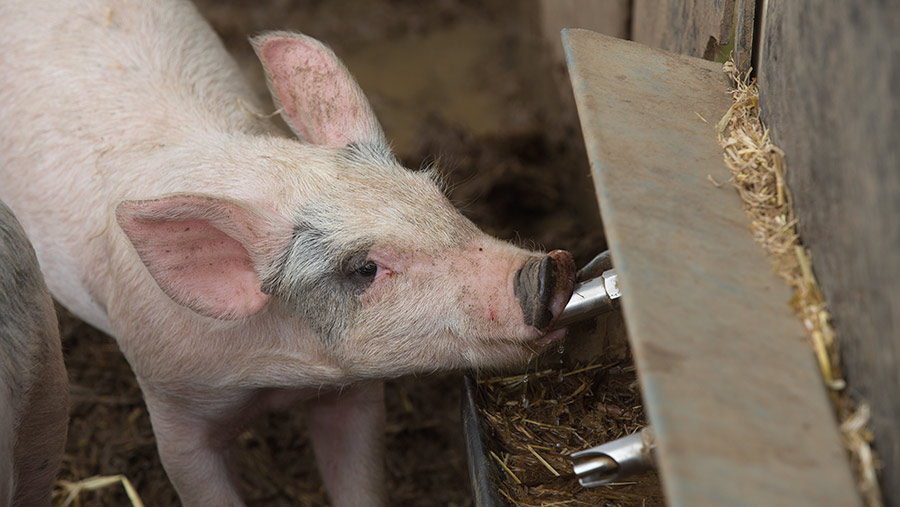How to control pig feed costs and maintain nutritional needs
 © Tim Scrivener
© Tim Scrivener Feed has always made up the largest share of total outgoings, recently rising from about 70% to at least 80%.
To help mitigate ongoing, high raw material costs, producers and their advisers need to be flexible towards nutritional strategies while being careful to fully meet the pig’s needs.
Faye Murch, a nutritionist at Kingsgate Nutrition, offers her top tips to help achieve this balance.
See also: Advice on weaning piglets
1. Formulate rations tightly
Producers and nutritionists must know the exact volumes and quality of the raw materials they have, to make sure rations are formulated as tightly as possible.
It is important to measure nutrient content and not just assume, to ensure you are working with an accurate figure and delivering a ration as close to the diet specification as possible.
For example, if you think the protein content of your wheat is 10.5% and it is 9.8%, it makes a big difference to the way protein is balanced in the ration.
Rations may need to be reviewed and reformulated every month, depending on which raw materials have been bought and at what price.
Try to make the most of the raw materials available based on their nutritional quality and cost at the time.
The aim should be to buy enough, but not too much, to maintain some flexibility in case prices change.
If wheat has been grown on the farm, it should be used first, rather than buying another cereal.
More soya is being included in diets than normal due to the expense of protein alternatives (particularly sunflower meal and rapeseed meal, with the former largely sourced from Ukraine and Russia).
However, producers and nutritionists need to be mindful that higher levels of soya can have a detrimental effect on young pigs’ gut health.
2. Work with your nutritionist and vet
Farmers, nutritionists and vets should work as closely as possible to identify better overall strategies for pig management.
For example, there might be times when they agree it is better to use vaccination than to adjust diets or, if more than one change is made, they can make sure they are complementary.
3. Optimise feed conversion ratio
A healthy pig is more efficient than a poorly one and can be fed a lower-density diet to achieve the same performance level.
Therefore, a range of factors must be managed to maintain pig health and help optimise feed conversion ratio (FCR) to make production more cost-effective:
- Water intake and quality are linked to feed intake and gut health. A Dosatron dosing pump can help clean and monitor waterflow rates and allow farmers to deliver additives via the drinking water. This might be cheaper than adding them via feed, depending on the circumstances.
- Avoiding a cold or draughty environment means less energy is diverted to keeping pigs warm.
- Aim for a strong, healthy piglet, with a good weaning weight; as a rule of thumb, a pig that weighs 1kg heavier at weaning will typically take one week less to reach finished weight.
- Make sure stocking density is optimal to minimise the risk of stress affecting health and feed efficiency.
- Check feed bins regularly for leakage and mould.
4. Optimise gut health
Promoting gut health plays an important part in maintaining overall health.
If gut health is poor and stools are loose, a proportion of nutrients are being lost
This is because the villi in the digestive tract are shorter, meaning nutrient absorption is reduced.
It is important to review the additives available and consider different options that may not have been tried before; keep open-minded and have a look at new trial results.
The possibilities include enzymes, pro- and prebiotics, synthetic amino acids, minerals and plant-derived phytobiotics.
Decisions should be made based on whether there will be a worthwhile return on the investment cost of the additive.
Returns could be achieved via an improvement in gut health and function, an increase in overall health, FCR or growth or potentially a reduction in antibiotics use.
It must be certain there is going to be a benefit for each specific farm concerned.
Non-starch polysaccharide degrading enzymes, known as energy-releasing enzymes, are commonly used to help break down starches to release energy.
Energy-sparing enzymes stop energy from being used unnecessarily by breaking down anti-nutritional factors. This gives pigs more energy to focus on growth and productivity.
Energy-sparing enzymes can also offer more flexibility in nutritional strategies as they enable dietary energy or protein to be lowered slightly, reducing costs while maintaining the same performance.
They can be added to diets without reducing other raw materials. This can help produce a stronger, healthier pig with better intestinal integrity and a greater chance to fulfil its potential throughout life.
5. Remember sow performance
While the biggest cost savings are to be made in the rearing and finishing stages, producers should not forget sow performance.
A well-managed sow that is milking properly will help produce more healthy piglets at a good weaning weight.
Minimise sow empty days and aim for a farrowing rate of 90% or more, and certainly no less than 85%.

